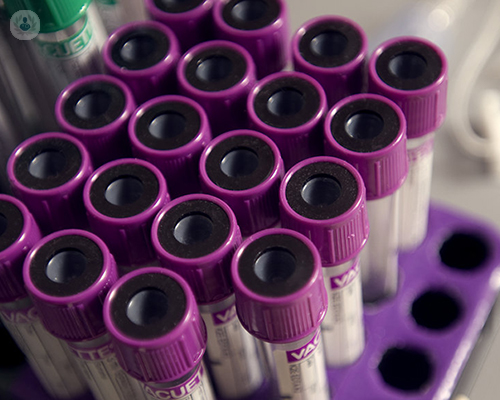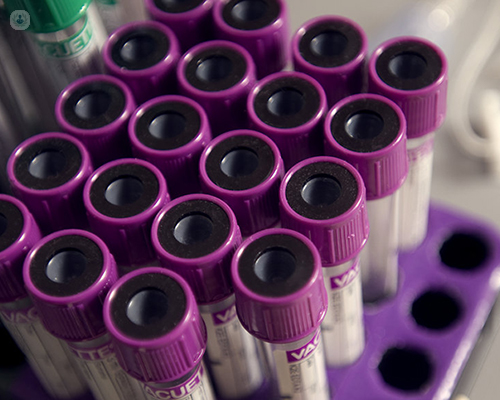
Complications and success in bone marrow transplant
Transplantation of haematopoietic stem cells or bone marrow does not come without some risks or complications for the person with haematological deficiencies or diseases. Conversely, there are hardly any risks for the donor. Advances in haematology have minimised complications for the recipient and the success rate is now greater than it was some years ago. Experts in haematology encourage the population to donate bone marrow, since it is the source of life for many patients.

Complications of bone marrow transplantation
Stem cell transplants and marrow transplants do not come without side effects. Some of the main complications, in order of frequency, are:
Infection
A bone marrow transplant usually requires the marrow of the recipient to be destroyed (myeloablation). Before the graft, patients can spend several weeks without enough white blood cells to help fight infection. This puts the patient at high risk of infection, despite the fact antibiotics are also prescribed.
Immunosuppressive agents used in allogeneic transplants for the prevention or treatment of graft versus host disease further increase the risk of opportunistic infection. Immunosuppressive drugs are given for a minimum of 6 months after a transplant, or longer, if necessary, to treat graft versus host disease. Transplanted patients lose their acquired immunity. For this reason, transplant patients should be re-vaccinated once the immunosuppressive treatment regimen has been completed.
Haemorrhage
Bone marrow produces platelets, which are cellular fragments that stick in regions where there are blood vessel wounds to limit blood loss. The destruction of cells that produce platelets makes severe bleeding more likely. Therefore, many patients require platelet transfusions during the days immediately following transplantation.
Vein-occlusive disease
Severe hepatic injury may result from veno-occlusive disease (VOD). Elevated levels of bilirubin, increased liver or spleen size, and fluid retention are clinical features of this disease. This is typical of allogeneic transplants, due to generalised cell injury and obstruction of the hepatic veins. Severe cases are associated with a high mortality rate. Treatment with anticoagulants may be effective in reducing VOD severity but may also increase haemorrhagic complications.
Mucositis
Mucosal lesions of the mouth or mucositis are a common complication in transplantation of hematopoietic progenitors. Normally they are not fatal, but they can be painful, and give the patient significant difficulty in eating or drinking. Mucositis is treated with pain medications as well as intravenous infusions of fluids to prevent dehydration and malnutrition. It is also treated with laser therapy, which relieves pain and allows the patient to ingest food. Eating cold foods such as ice cream can help to soothe symptoms of mucositis.
Graft-versus-host disease
Graft-versus-host disease is an inflammatory process, and characteristic of allogeneic transplantation. It is an attack on the ‘new’ immune cells of the bone marrow against the receptor tissues. This can occur even if the donor and recipient are HLA-identical (human leukocyte antigen) and therefore immunologically compatible, since the immune system can still recognise other differences between their tissues. High doses of cortico-steroids, such as prednisone, are the standard treatment. However, this immunosuppressive treatment often leads to deadly infections. Chronic graft-versus-host disease may also develop after an allogeneic transplant. It is the main source of treatment-related final complications, although it is not usually fatal. In addition to inflammation, it can lead to the development of fibrosis, as it can cause functional disability and requires prolonged immunosuppressive treatment. Graft-versus-host disease is usually mediated by T lymphocyte-like cells, which react with foreign peptides or antigens from different receptor tissues.
Graft versus tumour effect
The graft versus tumour effect or the ‘graft versus leukaemia’ effect is the beneficial aspect of the graft versus host phenomenon. For example, patients with acute or particularly chronic graft-versus-host disease after an allogeneic transplant tend to have a lower risk of cancer recurrence. This is due to a therapeutic immune reaction of the donor T lymphocytes against the diseased bone marrow of the recipient.
Graft versus tumour is the main benefit of transplants that do not employ the highest immunosuppressive regimens. Tumour grafting is primarily beneficial in slowly evolving diseases, such as chronic leukaemia, low grade lymphoma and, in some cases, multiple myeloma. However, it is less effective in acute leukaemia, given its rapid expansion and cellular growth capacity. If there is relapse of the cancer after a first transplant, a new implant can be made by infusing the patient with a greater amount of white blood cells (T lymphocytes) from the donor’s blood.
Bone marrow transplant prognosis
The prognosis varies widely depending on the type of disease, stage, stem cell source, HLA compatibility and conditioning regimen. Transplant offers a possibility of long-term cure or remission if the inherent complications of graft-versus-host disease, immunosuppressive treatments, and the spectrum of infections are managed. In recent years, survival rates have gradually improved. Mortality due to allogeneic transplantation is estimated at around 35-40%, and is lower for transplants with milder ablative regimens, also called mini-allografts (around 15%). Mortality for autologous transplants is low, at around 5%.

